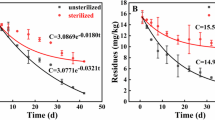Abstract
Chlordecone is an organochlorine insecticide that has been widely used to control banana weevil in the French West Indies. As a result of this intense use, up to 20,000 ha are contaminated by this insecticide in the French West Indies, and this causes environmental damage and health problems. A scenario of exposure was drawn by French authorities, based on land usage records. Many efforts have been made to monitor the occurrence of chlordecone and its main metabolites using different analytical methods, including GC, GC/MS, LC/MS, and NIRS. Although these different methods allow for the detection and quantification of chlordecone from soils, none of them estimate the bottleneck caused by extraction of this organochlorine from soils with high adsorption ability. In this study, we used 13C10-chlordecone as a tracer to estimate chlordecone extraction yield and to quantify chlordecone in soil extracts based on the 13C/12C isotope dilution. We report the optimization of 13C10-chlordecone extraction from an Andosol. The method was found to be linear from 0.118 to 43 mg kg−1 in the Andosol, with an instrumental detection limit estimated at 8.84 μg kg−1. This method showed that chlordecone ranged from 35.4 down to 0.18 mg kg−1 in Andosol, Nitisol, Ferralsol, and Fluvisol soil types. Traces of the metabolite β-monohydrochlordecone were detected in the Andosol, Nitisol, and Ferralsol soil samples. This last result indicates that this method could be useful to monitor the fate of chlordecone in soils of the French West Indies.


Similar content being viewed by others
References
Agency for Toxic Substances and Disease Registry (ATSDR) (1995) Toxicological profile for mirex and chlordecone. Atlanta, GA: U.S. Department of Health and Human Services, Public Health Service
Brunet D, Woignier T, Lesueur-Jannoyer M, Achard R, Rangon L, Barthès BG (2009) Determination of soil content in chlordecone (organochlorine pesticide) using near infrared reflectance spectroscopy (NIRS). Environ Poll 157:3120–3125
Cabidoche YM, Achard R, Cattan P, Clermont-Dauphin C, Massat F, Sansoulet J (2009) Long-term pollution by chlordecone of tropical volcanic soils in the French West Indies: a simple leaching model accounts for current residue. Environ Poll 157:1697–1705
Dolfing J, Novak I, Archelas A, Macarie H (2012) Gibbs free energy of formation of chlordecone and potential degradation products: implications for remediation strategies and environmental fate. Environ Sci Tech 46:8131–8139
Faroon O, Kueberuwa S, Smith L, De Rosa C (1995) ATSDR evaluation of health effects of chemicals. 2. Mirex and chlordecone: health effects, toxicokinetics, human exposure, and environmental fate. Toxicol Indus Health 11:1–203
Frenich AG, Vidal JLM, Frias MM, Olea-Serrano F, Olea N (2000) Quantitative determination of endocrine-disrupting polychlorinated biphenyls and organochlorinated pesticides in human serum using gas chromatography with electron-capture detection and tandem mass spectrometry. J Mass Spectrom 35:967–975
Le Déault JY, Procaccia C (2009) Les impacts de l’utilisation de la chlordécone et des pesticides aux Antilles: bilan et perspectives d’évolution. Report no. 1778 of French National Assembly, pp 223
Moriwaki H, Hasegawa A (2004) Detection of chlordecone by liquid chromatography with tandem mass spectrometry. Rapid Commun Mass Spectrom 18:1243–1244
PNAC (2008–2010) Plan d’action chlordecone en Martinique et en Guadeloupe: rapport interministériel d’activité (année 2009), pp 24
Wang B, Fukuya L, Yu G, Huang J, Wei Y, Yamazaki N, Chen J, Chen X, Jiang W, Morita M (2010) HRGC/HRMS analysis of mirex in soil of Liyang and preliminary assessment of mirex pollution in China. Chemosphere 79:299–304
Acknowledgments
The authors would like to thank Dr. Yves-Marie Cabidoche heartily: he was our mentor and, without him, this project would not have existed. This work was funded within the framework of a PTR contract delivered by Synerginov and of the research contract Biodechlord funded by INRA in the context of the research program Demichlord, part of the National Plan of Action for Chlordecone in the French West Indies. Chloe Merlin’s PhD thesis is funded by ADEME and the Regional Council of Burgundy. Authors would like to thank Marie-Danièle Marignier (Synerginov) for her help to establih the PTR. We also would like to thank Annie Buchwalter for editing the manuscript.
Author information
Authors and Affiliations
Corresponding author
Additional information
Responsible editor: Philippe Garrigues
Fabrice Martin-Laurent and Mehdi Sahnoun M are equal first authors.
Electronic supplementary material
Below is the link to the electronic supplementary material.
Fig. S1
Panel A. Mass spectrum of 12C-chlordecone. Panel B. Mass spectrum of 13C10-chlordecone. Panel C. Mass spectrum of β-monohydrochlordecone. Panel D. Mass spectrum of dihydrochlordecone. (PPT 221 kb)
Fig. S2
Influence of the homogenization buffer on the amount of 13C10-chlordecone extracted and quantified by GC-ECD/MS from the Andosol. Extraction 1: homogenization in phosphate buffer. Extraction 2: homogenization in phosphate buffer plus anhydrous sodium sulfate. (PPT 142 kb)
Fig. S3
Influence of the solvent on the amount of 13C10-chlordecone extracted and quantified by GC-ECD/MS from the Andosol. Extraction 3: pentane/acetone (v/v). Extraction 4: dichloromethane. (PPT 142 kb)
Fig. S4
Influence of the pH of the homogenization buffer on the amount of 13C10-chlordecone extracted and quantified by GC-ECD/MS from the Andosol. Extraction 5: 100 mM phosphate buffer at pH = 3. Extraction 6: 100 mM phosphate buffer at pH = 7. Extraction 7: 100 mM phosphate buffer at pH = 11. (PPT 163 kb)
Rights and permissions
About this article
Cite this article
Martin-Laurent, F., Sahnoun, M.M., Merlin, C. et al. Detection and quantification of chlordecone in contaminated soils from the French West Indies by GC-MS using the 13C10-chlordecone stable isotope as a tracer. Environ Sci Pollut Res 21, 4928–4933 (2014). https://doi.org/10.1007/s11356-013-1839-y
Received:
Accepted:
Published:
Issue Date:
DOI: https://doi.org/10.1007/s11356-013-1839-y




